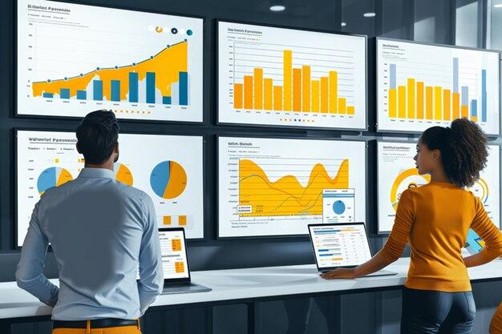
07
Oct,24Data Visualization-How to Tell Your Business Story with Data
As pointed out by many scholars, competition in today’s world is mainly information-based. That is why raw data still present some challenges of analysis especially when trying to understand and interpret them. That is where data visualization steps in. Data visualization aims to depict logical information in the forms of charts, graphs, and other graphical interfaces making it easier for businesses to tell their story and make probable decisions.
Data Visualization:
Data Visualization is the act of representing data in a picture form involving the use of charts, graphs, maps, or illustrations. This means that even people with a limited quantitative background can easily consume, analyze, and communicate data.
Data Visualization Importance
● Improved Understanding: Graphical representation of data makes complex ideas more comprehensible and easily digested.
● Enhance decision-making: Data visualization helps to identify the trends, patterns, and anomalies that one cannot deduce from a raw data perspective.
● Effective Communication: Much show and tell can be done with a visual rather than with text alone, making it much easier to communicate insights with stakeholders.
● Storytelling: Data visualization helps you tell an interesting story about your business, therefore communicating your successful points and insight.
Key Principles of Data Visualization
● Clarity: It means that on-screen activities and everything on the screen should be clear, do not clutter, and be straightforward.
● Relevance: The visuals have to be relevant and wield effective information in regards to narrating a story.
● Consistency: Use consistent colors, fonts, and styles across the visualizations.
● Interactivity: Through interactive visualizations, users can browse at their own pace and learn things from them in a way that static visualizations could never capture.
Common Data Visualization Techniques
● Bar Charts: Useful for comparing values across different categories.
● Line Charts: Ideal for showing trends over time.
● Pie Charts: Effective for representing proportions of a whole.
● Scatter Plots: Show the relationship between two variables.
● Maps: Visualize data geographically.
● Infographics: Combine text, images, and charts to tell a story in a visually appealing way.
Tools for Data Visualization
● Excel: A versatile tool for creating basic charts and graphs.
● Tableau: A powerful data visualization platform with a user-friendly interface.
● Power BI: A cloud-based business intelligence tool from Microsoft.
● Python Libraries: Libraries like Matplotlib, Seaborn, and Plotly offer advanced customization options for data visualization.”
Data visualization is an effective tool that can enable you to share your business story with the use of data. This article indicated some principles in visualizations and if implemented alongside the right tools, then one can be well equipped to make interesting visualizations that elicit the right action and emotions.
Data Visualization:
Data Visualization is the act of representing data in a picture form involving the use of charts, graphs, maps, or illustrations. This means that even people with a limited quantitative background can easily consume, analyze, and communicate data.
Data Visualization Importance
● Improved Understanding: Graphical representation of data makes complex ideas more comprehensible and easily digested.
● Enhance decision-making: Data visualization helps to identify the trends, patterns, and anomalies that one cannot deduce from a raw data perspective.
● Effective Communication: Much show and tell can be done with a visual rather than with text alone, making it much easier to communicate insights with stakeholders.
● Storytelling: Data visualization helps you tell an interesting story about your business, therefore communicating your successful points and insight.
Key Principles of Data Visualization
● Clarity: It means that on-screen activities and everything on the screen should be clear, do not clutter, and be straightforward.
● Relevance: The visuals have to be relevant and wield effective information in regards to narrating a story.
● Consistency: Use consistent colors, fonts, and styles across the visualizations.
● Interactivity: Through interactive visualizations, users can browse at their own pace and learn things from them in a way that static visualizations could never capture.
Common Data Visualization Techniques
● Bar Charts: Useful for comparing values across different categories.
● Line Charts: Ideal for showing trends over time.
● Pie Charts: Effective for representing proportions of a whole.
● Scatter Plots: Show the relationship between two variables.
● Maps: Visualize data geographically.
● Infographics: Combine text, images, and charts to tell a story in a visually appealing way.
Tools for Data Visualization
● Excel: A versatile tool for creating basic charts and graphs.
● Tableau: A powerful data visualization platform with a user-friendly interface.
● Power BI: A cloud-based business intelligence tool from Microsoft.
● Python Libraries: Libraries like Matplotlib, Seaborn, and Plotly offer advanced customization options for data visualization.”
Data visualization is an effective tool that can enable you to share your business story with the use of data. This article indicated some principles in visualizations and if implemented alongside the right tools, then one can be well equipped to make interesting visualizations that elicit the right action and emotions.
Comments
No Comments.....!
